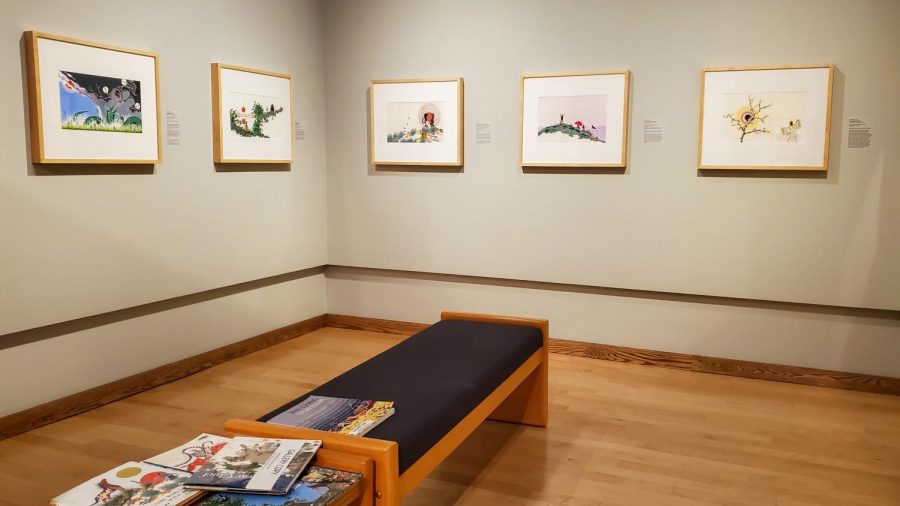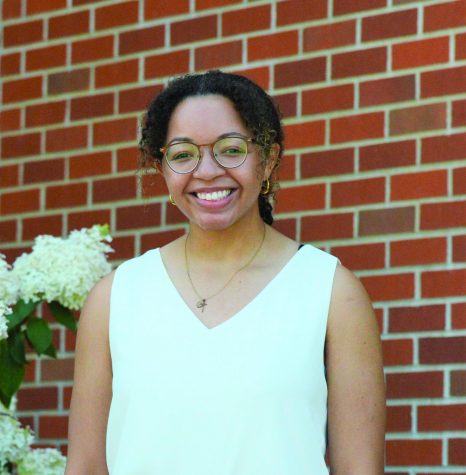Art museum in full bloom
October 8, 2021
The South Dakota Art Museum on campus installed three new exhibits over the summer—The Radiant Sun by Paul Goble, Florals by Lowell Nesbitt and Moment to Moment by Martin Weinstein. Curator Jodi Lundgren discusses the exhibits and why she brought them to the museum.
“(They) were specifically curated to be up at the same time in response to the distress most all of us have experienced in the past year,” Lundgren said. She explains the exhibits are meant to display artwork with “real surface appeal but with deeper messages, connections and innovations” for people to contemplate if they want.
The three exhibits demonstrated themes of nature, with the focal points being suns, flowers and landscapes, and each artist has a unique take on the subject matter.
“I felt like people could use an extended summer in that sense,” Lundgren said. “A place to go before, during and after their own summer gardens and experiences bloom … a safe space during such troubling times for humankind.”
The Radiant Sun: Illustrations, May 10-Nov. 22
Paul Goble was an author and illustrator of several children’s books that depicted Native American legends and traditions. Born in Haslemere, England in 1933, Goble moved to Rapid City in 1977 where he was adopted by Chief Edgar Red Cloud. His illustrations are often made with watercolor and ink, and the exhibit includes the stories and descriptions that go along with them. Goble died in 2017.
“Goble’s sun is a very specific kind of sun,” Lundgren said. “(It) is really a symbolically and mythologically potent spirit more than an astronomical or physical phenomenon. His style is unique, but it often draws upon the War Bonnet design and its rich symbolism, so the sun isn’t (just) a backdrop or object of beauty but so much more than that.”
Florals, June 12-Oct. 24
Lowell Nesbitt was an American artist best known for his silkscreen florals and connection to the Pop Art movement. Nesbitt was born in Baltimore in 1933, and it was his high school job as a night watchman in a museum in Washington, D.C., that inspired him to become an artist. “Florals” is drawn from the museum’s Cockerline Collection; Neil Cockerline gifted the prints in memory of his mother, Florence Cockerline. Nesbitt died in 1973.
“The forms of the flowers have a centering effect in their universal, natural beauty,” Lundgren said, “and the way that Nesbitt removed the background from the florals so it is just the flower itself—often centered and symmetrical on a stark flat-colored background—emphasizes this even more. The floral prints can read as both portraits and mandalas [geometric symbols used in various spiritual traditions].”
Moment to Moment, June 23-Nov. 7
Martin Weinstein was born in 1952 in New York City. His father, who was an artist as well, taught him to paint. His recent works include landscapes paintings that are layered on transparent acrylic sheets, each sheet a depiction of the same scene but at different times or seasons, sometimes even painted years apart. As people walk around the gallery, they realize the scenes shift and change with their movement.
“He makes his paintings speak so much more to memory and the human experience of the beauty of landscape rather than about a specific moment of natural beauty,” Lundgren said. “In that sense, they are truer to our actual experience, so in the end, they are … more about the human experience than idolizing a static moment of beauty.”
The museum is open weekdays from 10 a.m. to 5 p.m., Saturdays from 10 a.m. to 4 p.m., and Sundays from noon to 4 p.m. Admission is free. Other current exhibits include the complete Harvey Dunn collection, recent acquisitions and the permanent Marghab Linens exhibit.























